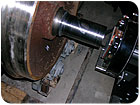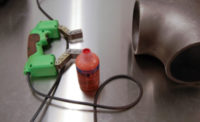
Magnetic particle inspection has proven to be a reliable full body inspection method to locate indications quickly and economically. Source: Magnaflux
The subject of magnetic particle inspection encompasses flux, current path, probability of detection or UV light. The topic of magnetic particle inspection can be best understood by providing an application example. No matter the application, operators look for flaws, and hope they find them.
Magnetic particle inspection (MPI) is used to inspect the fastener on the seatbelt, anchoring the belt to the car frame. MPI inspects the steel brake caliper castings. Think of those two simple parts and the simple test next time your car has to stop quickly. MPI is used to inspect amusement park rides, ski lifts and racing engines. Roller coaster fans should remember that the next time they decide to seek a thrill and feel the “G” forces on their bodies. MPI is used to inspect landing gear, jet engines and hydraulic cylinders. Flying is safe because great care is taken to find issues before they become bad.
MPI is used to inspect pipes when they are made, and welds as pipes are joined and fittings to hold the shut off valves. Do not forget the damage a chemical spill can cause. MPI inspects the wheels on trains, the coupling holding the cars, the axles and bearings supporting the weight of coal, automobiles or grain. Transporting by rail is like moving a ton of freight at 410 miles per gallon.
MPI is one of the easiest methods to learn, one of the most repeatable processes and one of the least expensive systems to maintain in the NDT industry. From a production perspective it may seem to cost time and money for no value added to the part. Not adding value is a point on which people disagree; for every flawed part found there is an infinite value. Society gets its energy more reliably, and people get thrills without fear and have the ability to go places for business and pleasure without concern. They come home safely.
Testing Key Components
Rail traffic in recent years has increased significantly. Longer trains, heavier loads and more trains all are showing resurgence partially because the rail industry has made good economic arguments for transportation of freight. With the resurgence there also has been an increase of car failures due to the increased fatigue. Reacting to the failures, the American Association of Railroads has been reviewing its procedures for testing new and in-service components. The results to date are a refinement in the original processes with some enhancements to ensure better probability of detection.As with many industries, the association reviewed how the procedures were currently set up. Then they reviewed changes in the processes to manufacture these components, as well as changes in technology to test these components. One reality that was quickly reinforced was magnetic particle inspection proved to be one of the most reliable full body inspections to locate indications quickly and economically.
Simple process enhancements such as white contrast paint or high output UV lamps could help field inspection. Deeper monitoring of process parameters in the off-rail facilities as well as better education of the federal auditors can all be used to make the rails even more reliable and cost effective.
Being stopped at a railroad crossing allows drivers to examine the rail cars and the cargo they carry: for example, coal, wood, automobiles, corn sweetener, alcohol, ammonia and chlorine. Each car may have eight wheels, four axles, two bolsters and four side frames. The couplings are a heavy piece of steel, but imagine the weight it holds. Imagine the miles of track each car sees in a year, the stress cycles, the start and stop of a long train, that domino of thunder as the cars start to move.

Magnetic particle inspection is used to inspect the wheels on trains, the coupling holding the cars, the axles and bearings supporting the weight of coal, automobiles or grain. Source: Magnaflux
Inspection Matters
According to reports from the Federal Railroad Administration (part of the National Transportation Safety Board), of the first 68 rail accidents reported for 2007, three causes in particular stood out. In one accident 19 cars derailed. The cost of equipment and materials lost totaled approximately $400,000. The cause was determined to be from a broken axle; fatigue cracks in axles are one of the flaws MPI equipment is designed to find.Specifically designed magnetic particle equipment has been in place for more than 50 years. Some of the magnetic particle equipment has been rebuilt several times, some of it has been replaced with new and some of it continues to limp along.
Another accident of 25 cars derailing cost more than $700,000. A broken rim on one of the wheels allowed the car to slip off the track and lead the next seven cars into the road bed, followed by the next 18 cars piling into each other as the momentum pushed them forward into a wall of steel. Again, a properly applied magnetic field could have easily found the beginning of a flaw before detrimental failure. The rims are normally reviewed with ultrasound, but fatigue cracks can develop from induced stress points and MPI can locate many of these surface indications with little effort.
In a third accident, a fatigue crack on a bolt hole allowed the bolt to slip out. The result was a 29-car pile up, with more than $2.2 million in damage. It may not be possible to determine if the bolt slipped the day before, the week before or at that very moment of the accident. It also is difficult to point fingers after the fact.
What one can say is for every flaw, crack or indication discovered through magnetic particle inspection, people save money. In the three accidents described, a simple 30-second test and inspection could have saved more time and money than anyone could imagine.
The safety of one’s friends and family, the reliability of transportation and the ability to get goods on time all rely on a simple test. Every accident is the result of a sequence of events. If one can alter that sequence anywhere along the way, it is possible to keep the accident from ever happening.
When a part is tested with the MPI process, and the beginning of the fatigue crack is discovered, operators make a decision: fix it, replace it and monitor it. They make the decision to change the sequence. NDT
